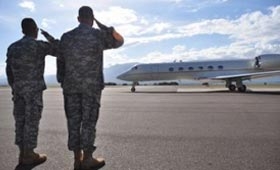The chief of the US Southern Command has suggested a growing interest in combating Central American criminal groups, though it’s not clear that greater involvement of the US military would have a positive impact on security in the region.
In his appearance before the Senate Armed Services Committee on March 13, Air Force General Douglas Fraser emphasized that the Southern Command (SouthCom) has its eye on the crime-ridden nations of Central America. He told the panel that criminal groups operating in the region are “seriously impacting citizen safety in Central America, especially Guatemala, El Salvador and Honduras,” adding that they “threaten to overwhelm law enforcement capacities.”
This followed an appearance a week earlier before the House Armed Services Committee, in which Fraser sounded many of the same notes:
We’re seeing that now some of that supply of cocaine — and I’ll talk specifically cocaine — is moving through South America, as well as Central America. But the violence continues to increase in Central America, and that’s where and why we are focusing there. Last year the UN estimated or said that Honduras has the highest violence of any country in the world. And we see that as a direct influence of transnational organized crime, but there are gangs and there are other factors.
Other moves by the US military have signaled a willingness to increase its role in Central America. The US recently agreed to build a base for the Dominican Navy on a small island adjacent to the Caribbean nation’s mainland, which will be used by Dominican forces to crack down on cocaine shipments passing through the region.
US forces have erected similar installations in Belize, Nicaragua, Panama, Guatemala, and Costa Rica. The US military also operates a permanent air base with 600 troops in Honduras.
Furthermore, Fraser’s comments and the increased focus on Central America come amid an ongoing decline in US military involvement in Colombia, long a focus of SouthCom’s operations. As detailed by blog Just the Facts, US military and police aid to Colombia is set to drop from more than $400 million to just over $260 million from 2008 to 2013.
In short, it appears that SouthCom is casting about for a new mission, and Central America could fill that role. As Fraser mentioned, El Salvador and Honduras suffer from the highest murder rates in the world, and while Guatemala has grown safer in recent years, it too remains very violent. Furthermore, thanks to the crackdown under Felipe Calderon, analysts believe that Mexican trafficking groups are increasingly moving their operations to Central America.
Mexico cannot provide SouthCom with its new mission, however. While US military officials have strengthened their links to their Mexican counterparts in recent years, SouthCom’s area of operation begins at Mexico’s southern border.
However, these two drivers of US attention to Central America — increased cocaine traffic and extreme levels of violence — could present the US with conflicting goals. Cracking down on criminal networks will almost certainly generate more instability in the near term, as surviving gangs fight to protect their position in a changing environment. Pursuing a decrease in violent activity, in contrast, requires a very different set of policies, from selective enforcement to long-term efforts to build more effective institutions.
Given this conflict, it’s not clear that a greater US military presence would have a positive impact, regardless of Central American governments’ embrace of US assistance. And while militaristic and “mano dura” (iron fist) policies undoubtedly have an appeal in blood-soaked nations, the get-tough philosophy has largely failed to improve public security, whether in Mexico under Calderon or El Salvador under Antonio Saca.
SouthCom may be able to help partner nations implement an aggressive approach with more efficiency and better resources, but it’s hard to see a militaristic, enforcement-first approach succeeding in reducing violence simply because a more efficient organization is leading the charge. It becomes even harder to envision such a scenario when one considers that street gangs, and not the international syndicates that the US military has experience confronting, are behind a huge proportion of the violence in Central America.
Proponents of greater US military aid to Central America often point to Colombia’s recent security improvements as a model, but there are problems with the comparison. The most obvious is that, when Plan Colombia kicked off, Colombia was suffering from a decades-long civil war, with insurgent groups controlling vast tracts of the country. While Colombia has done much to reduce the power of the biggest rebel group, the Revolutionary Armed Forces of Colombia (FARC), the circumstances are very different in Central America, where one fallen criminal cell is easily replaced by another. Furthermore, Colombia’s criminal groups remain active and violent, and the nation’s drug production has only been displaced to other countries, not eradicated.
Ultimately, the iron fist approach does nothing to address deep-rooted institutional problems that make Central American state agencies so ripe for corruption, and make the region so appealing for transnational gangs. SouthCom’s increased involvement could theoretically aid these efforts to develop more effective crime-fighting institutions (as opposed to, say, just arming local militaries and chasing drug traffickers), but the US military is not designed for institution building. An increased US military role is, then, not likely to be the answer to Central America’s public security problems.
(Photo, above, shows commanders at Soto Cano air base in Honduras saluting as General Douglas Fraser’s plane departs, after a visit in 2009.)

